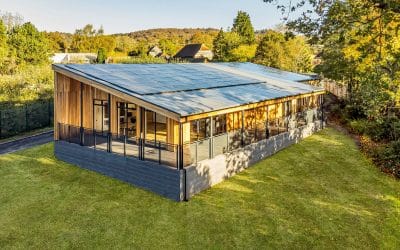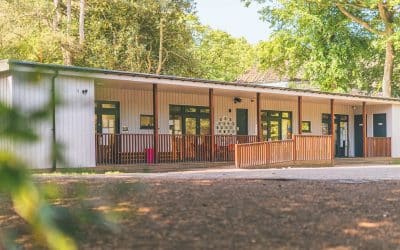TG Escapes Blog
Unique Modular Buildings
Constructing modular buildings is by no means a modern trend. For decades modular buildings have been built right across the world for both temporary and permanent solutions in all sectors of society.
Quick to build, hassle free and versatile, it’s easy to see why in recent years the adoption of modular buildings has surged dramatically and in some unusual and innovative ways. In this article we thought we would look at some of the most unique modular building designs across the world, both old and new, and how the modular process shaped them.
Rintala Eggertsson Architects’ Boxhome

A design project that began in Oslo, Norway, the Boxhome, which was the brain-child of the architect Rintala Eggertsson, is the embodiment of simplicity in its purest form. The Boxhome appears, on the outside, to be just that: a box. However, it’s when you look inside this quirky prefabricated home that the genius of the Boxhome’s design becomes evident.
Covering an area of 19 sqm, the eco-friendly and sustainable Boxhome comprises of a timber frame clad in aluminium and encasing four reasonably spacious rooms. The box has a kitchen (with a dining area), a bathroom, living room and bedroom with each room being constructed from a different species of wood to vary the design and colouration of the interior and give a distinct identity to each room.
Whilst not strictly modular, the design is open to the possibility of being included in a modular construct due to its easily stackable and minimalist design. Furthermore, the Boxhome is actually quite economical as well as ecological, costing about the quarter of the price of an apartment of a similar size in the same district.
Vijayawada Garden Estate Tower

http://www.home-of-penda.com/
Currently still under construction, the Garden Estate Tower in Vijayawada, East India, is both a stunning and innovative example of the benefits of modular constructs. The tower was designed by the Chinese architect studio Penda for the Indian developer Pooja Carfted Homes as a unique way to make a living space as personalised as possible in a busy city.
Based off the design of a modular shelving unit, the tower uses a structural grid to support individual ‘cubicles’ which make up the rooms of the tower’s flats. In this way, rooms are literally slotted into the building exactly the same way shelves and drawers would in a modular shelving unit. The idea is for residents to buy a ‘slot’, or several of them, and fill them with a module of their choice from an extensive range of rooms in the company’s catalogue.
In this respect, the structural grid and infrastructure of the Vijayawada Garden Estate Tower are the only permanent elements of the building with every space in the grid able to accommodate one of the bespoke modules chosen by the residents. Whilst this may seem odd, and leave the tower looking like an unfinished, skeletal derelict, this couldn’t be further from the truth. To keep the visual aesthetic of the tower appealing, extensive high-rise gardens have been built into the frame, not only alleviating the feeling of emptiness to those ‘shelves’ yet to be filled, but also providing an elevated garden for those that have.
The Floating House

http://www.mos.nyc/project/floating-house
From a distance, you might be mistaken for thinking this building is just a regular timber house in the countryside of Ontario, Canada. However, the closer you get to this house, the more you will realise there is something very odd about it…
Designed by MOS Architects, this Canadian house floats on top of Lake Huron like a raft! Made from Ceder planks and timbers, the Floating House has been designed to be a contemporary take on the Canadian log cabin, using steel pontoons and a broad platform to allow the house not only to float on the water but move with the Lake’s tidal waves.
With large windows and a view across the entirety of Lake Huron, the house provides a tranquil setting to live in amidst the stunning scenery surrounding it. Due to its remote location, the building, along with its land-bound sister cottages nearby, had to be built using modular parts that were brought in from the construction facility. This included the vast platform which serves to keep the house afloat and incorporates a dock, boat storage area, bridges to the shore and a sauna!
Habitat 67

http://www.habitat67.com/
Elsewhere in Canada, within the city of Montreal, there is another modular construction which has been around for nearly sixty years. Habitat 67 was built in 1967 as part of the Expo world exhibition held in Canada and was originally designed to provide affordable and community focused accommodation for local residents.
Designed by the Israeli born architect Moshe Safdie, the residential complex was built as a single construct made up of 354 prefabricated concrete forms which were brought to the site and assembled together in various combinations. This 12 storey high construct is a particularly bizarre sight amongst the majority of Montreal’s buildings with each ‘unit’ varying in size, function and orientation creating a peculiar jumbled effect across the construct.
Whilst Habitat 67 was originally intended to be an experiment in community building and affordable, social housing, the building has now moved quite far away from its initial purpose. These days, a penthouse at Habitat 67 could set you back by up to $2 million!
Backcountry Hut Company

http://www.thebackcountryhutcompany.com/
In a similar, but perhaps less severe line to Rintala Eggertsson’s Boxhome, the Vancouver based start-up known as the Backcountry Hut Company aims to create affordable and minimalist structures which are easy to build and versatile. However, rather than being built in a city and restricted to a 19 sqm, the building designed by Backcountry Hut Company are designed to provide a personalised residence or facility in the countryside.
Starting off as a simple ‘shell’ design, these buildings can have further ‘shells’ added to them to create the perfect sized building for the purchaser’s needs. Taking inspiration from IKEA’s famous furniture, the buildings can be likened to a flat-pack construct whose main components and structure are assembled offsite in a quality-controlled factory and then stacked and transported to the desired location.
Because of this, the construction process is particularly good for rural areas, as it not only allows large buildings to be built with ease in remote areas, but also causes minimal disruption to the surrounding area and negating any negative impact on the environment. The scalable design of the ‘shell’ also means that the building can be expanded with ease and at a moment’s notice.
More posts from our blog
The Power of Biophilic Design Within Education
Pupils today face a wealth of issues, from mental and physical health problems, to complex SEND needs. As designers and producers of modular school buildings across the UK, we are finding increasing demand for positive environments that uplift students and staff,...
TG Escapes Win Contractor of the Year 2021
Now in its 9th year Education Estates®, the annual gathering of the Education Community, with conference and awards in partnership with the Department for Education, saw over 100 exhibits and more than 150 speakers across 6 stages! The event is all about discovering...
Construction faces the perfect storm and costs are rising
The construction industry is facing 'the perfect storm'. The impact of Covid has been to delay many construction projects which are now coming back into play. Brexit has caused disruption in the supply chain and these two factors together are creating an increase in...



